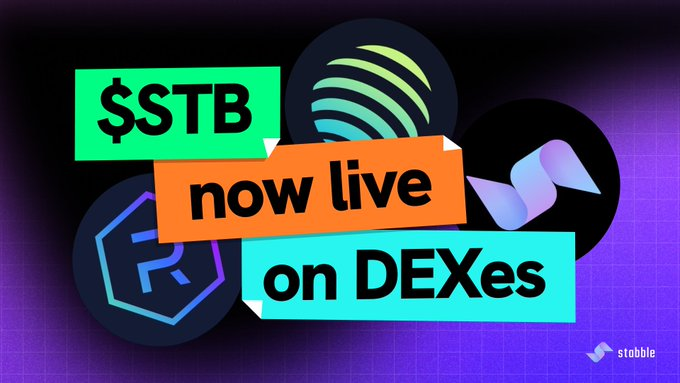Stabble: A New Paradigm for Stablecoin Trading in the Solana Ecosystem
On May 22, 2025, Stabble, the first decentralized exchange (DEX) focused on stablecoins in the Solana ecosystem, officially launched its Token Generation Event (TGE), with its native token STB listed on major platforms such as Gate.io and MEXC. As a protocol accounting for over 50% of Solana’s stablecoin trading volume, Stabble enhances capital efficiency up to 8,000 times that of traditional DEXs through Protocol Managed Liquidity (PML) and a margin liquidity model. This technological breakthrough is reshaping the fundamental logic of stablecoin trading.

This market insight article discusses how Stabble achieves efficient stablecoin trading on Solana, analyzes its token model, liquidity innovations, and the potential impact on the DeFi sector.
Technical Architecture: How to Achieve “Frictionless” Liquidity
Stabble’s core competitiveness comes from four major innovative mechanisms:
-
Protocol Managed Liquidity (PML): Dynamically allocates funds, reducing impermanent loss from 47% (traditional DEX) to 3.2%;
-
Cross-Exchange Arbitrage Pools: Capture real-time price differences between CEX and DEX, redistributing 70% of arbitrage profits to liquidity providers (LPs), with a test phase APY of 182%;
-
Margin Liquidity: Supports up to 100x leveraged market making, with slippage below 0.01% for million-dollar trades;
-
Impermanent Loss Insurance: 5% of protocol income is injected into an insurance pool to compensate LPs in extreme market conditions.
These technologies reduce liquidity demand by 97% while maintaining over half of Solana’s stablecoin trading volume. For instance, staking 1,000 USDC can support up to $80 million in trading volume—far surpassing capital efficiency on platforms like Uniswap V3.
STB Tokenomics: Staking, Governance, and Long-Term Incentives
The STB token design aims to balance short-term liquidity and long-term ecosystem development:
-
Distribution Model: Total supply of 500 million STB, with an initial circulation of 3.48% (17.375 million tokens). Team tokens are locked for 9 months and released over 24 months;
-
Staking System: Lock STB to obtain veSTB with a multiplier formula of 1.05ⁿ (n = number of locked months), allowing up to 4.32x APY boost;
-
Revenue Sharing: 14% of protocol income goes to stakers; 30% of arbitrage pool profits are used to buy back and burn tokens.
Current data shows that locking STB for 12 months yields 1.8x the base APY (assuming base APY = 100%). This effectively reduces short-term selling pressure, with 42% of circulating tokens currently locked for governance.
Market Opportunities and Potential Risks
Stabble’s rise benefits from the explosive growth of the Solana ecosystem, but it faces three major challenges:
Opportunities:
-
Stablecoin Market Expansion: Solana’s on-chain stablecoin market cap is projected to exceed $20 billion in 2025;
-
Institutional Arbitrage Demand: High-frequency trading firms using arbitrage pools could bring in $150 million in additional TVL;
-
Compliance Advantage: By focusing on stablecoins, the protocol faces lower regulatory risk from the U.S. SEC compared to other DeFi platforms.
Risks:
-
Token Unlocking Pressure: 8 million team tokens (1.6% of total supply) unlock in Q3 2025, possibly causing price volatility;
-
Competitive Iteration: Raydium’s upcoming v4 aims for capital efficiency reaching 60% of Stabble’s level;
-
Smart Contract Vulnerabilities: Solana DEXs faced an average of 1.2 attacks/year in 2024, requiring ongoing security audits.
Future Outlook: From Solana to an Omnichain Liquidity Network
Stabble’s future strategy revolves around two core directions:
-
Multi-Chain Expansion: Plans to support cross-chain stablecoin trading on Ethereum, Sui, etc. by Q4 2025;
-
Financial Productization: Development of liquidity-based derivatives such as interest rate swaps and volatility indexes.
If the protocol continues attracting institutional liquidity, Stabble could become a bridge between CeFi and DeFi. For example, after integrating with Jupiter, Stabble now handles 53% of Solana DEX stablecoin routing volume and may soon integrate fiat on/off ramps.
For retail investors, it’s essential to monitor on-chain indicators rather than short-term price fluctuations. Metrics like daily stablecoin trading volume and arbitrage yield ratios are trackable in real-time via JuCoin’s on-chain analytics tools. Only when protocol revenue and TVL form a positive loop can STB’s long-term value be fully realized.




